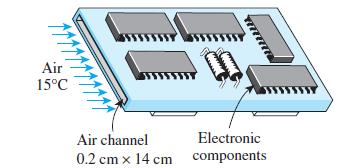Reconsider Prob. 858. Using EES (or other) software, investigate the effects of air velocity at the inlet
Question:
Reconsider Prob. 8–58. Using EES (or other) software, investigate the effects of air velocity at the inlet of the channel and the maximum surface temperature on the maximum total power dissipation of electronic components. Let the air velocity vary from 1 m/s to 20 m/s and the surface temperature from 30°C to 90°C. Plot the power dissipation as functions of air velocity and surface temperature, and discuss the results.
Data from problem 58
A 15-cm × 20-cm printed circuit board whose components are not allowed to come into direct contact with air for reliability reasons is to be cooled by passing cool air through a 20-cm-long channel of rectangular cross section 0.2 cm × 14 cm drilled into the board. The heat generated by the electronic components is conducted across the thin layer of the board to the channel, where it is removed by air that enters the channel at 15°C. The heat flux at the top surface of the channel can be considered to be uniform, and heat transfer through other surfaces is negligible. If the velocity of the air at the inlet of the channel is not to exceed 4 m/s and the surface temperature of the channel is to remain under 50°C, determine the maximum total power of the electronic components that can safely be mounted on this circuit board. As a first approximation, assume flow is fully developed in the channel. Evaluate properties of air at a bulk mean temperature of 25°C. Is this a good assumption?
Step by Step Answer:

Heat And Mass Transfer Fundamentals And Applications
ISBN: 9780073398181
5th Edition
Authors: Yunus Cengel, Afshin Ghajar




